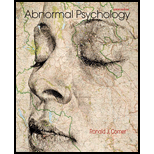
Concept introduction
Reliability and validity are important concepts in scientific research. “Reliability” refers to how consistent a test's result is, while “validity” refers to the extent to which the test measures what it is supposed to. These concepts determine the usefulness of a test and allow us to infer whether it is a good tool to assess the given construct.
Explanation of Solution
Answer and explanation
Recently, there has been an increase in the use of standardized tests in schools. While they do usually happen to be valid and reliable, most of the tests that a student takes in school are not tested for these properties. Class tests have face validity, implying that it looks from the question that the test is measuring what it is supposed to, but that does not correspond to content or construct validity. Since most of the tests are based on the information given in textbooks, they have some content validity.
When it comes to reliability, class tests that are objective or are based on facts tend to have high inter-rater reliability, while those that measure a subjective quality, such as creative writing and art, tend to have low inter-rater reliability. In general, the reliability and validity of these tests depends on the test maker. Without any formal analysis, one cannot ascertain how useful a test it is.
Tests that are published in magazines and are available online rarely have any validity or reliability. Since they often do not operationalize the variable that they claim to measure, these tests do not have high validity or reliability. The aim of these tests is to have high face validity, to make the test taker feel that the test is useful. Hence, they lack any real validity. Also, since many of these tests measure variables that are influenced by extraneous factors, such as mood, they tend to have low test-retest reliability.
Want to see more full solutions like this?
- what makes the candomble tradition stand out?arrow_forwardby observing behavior students in class , what your thoughts about the effectiveness and purpose of the work being done there?arrow_forwardWhen would using checklists and rating scales be most appropriate in early childhood? Use scholarly sources.arrow_forward
- I need help with two articles are there any similarities and differences between the two https://www.phnompenhpost.com/business/indian-ambassador-pledges-increased-trade-tourismpromotion, https://time.com/5486460/pol-pot-cambodia-1979/arrow_forwardEvaluate the application of behaviourism and cognitive psychological perspectives to contemporary issues in psychology.arrow_forwardAnalyse the similarities and the differences between behaviourism and cogniperspectives in psychology.arrow_forward
- Describe behaviourism and cognitive psychological perspectives.arrow_forwardEvaluate the key assumptions of behaviourism and cognitive psychological perspectives.arrow_forwardable to help me with this for revision purposes and used reference in APA Required reading: • McKevitt, G. (2024, September 2). https://www.bbc.com/culture/article/20240829-the-life-changing-day-world-war-two-beganarrow_forward
 Ciccarelli: Psychology_5 (5th Edition)PsychologyISBN:9780134477961Author:Saundra K. Ciccarelli, J. Noland WhitePublisher:PEARSON
Ciccarelli: Psychology_5 (5th Edition)PsychologyISBN:9780134477961Author:Saundra K. Ciccarelli, J. Noland WhitePublisher:PEARSON Cognitive PsychologyPsychologyISBN:9781337408271Author:Goldstein, E. Bruce.Publisher:Cengage Learning,
Cognitive PsychologyPsychologyISBN:9781337408271Author:Goldstein, E. Bruce.Publisher:Cengage Learning, Introduction to Psychology: Gateways to Mind and ...PsychologyISBN:9781337565691Author:Dennis Coon, John O. Mitterer, Tanya S. MartiniPublisher:Cengage Learning
Introduction to Psychology: Gateways to Mind and ...PsychologyISBN:9781337565691Author:Dennis Coon, John O. Mitterer, Tanya S. MartiniPublisher:Cengage Learning Psychology in Your Life (Second Edition)PsychologyISBN:9780393265156Author:Sarah Grison, Michael GazzanigaPublisher:W. W. Norton & Company
Psychology in Your Life (Second Edition)PsychologyISBN:9780393265156Author:Sarah Grison, Michael GazzanigaPublisher:W. W. Norton & Company Cognitive Psychology: Connecting Mind, Research a...PsychologyISBN:9781285763880Author:E. Bruce GoldsteinPublisher:Cengage Learning
Cognitive Psychology: Connecting Mind, Research a...PsychologyISBN:9781285763880Author:E. Bruce GoldsteinPublisher:Cengage Learning Theories of Personality (MindTap Course List)PsychologyISBN:9781305652958Author:Duane P. Schultz, Sydney Ellen SchultzPublisher:Cengage Learning
Theories of Personality (MindTap Course List)PsychologyISBN:9781305652958Author:Duane P. Schultz, Sydney Ellen SchultzPublisher:Cengage Learning





